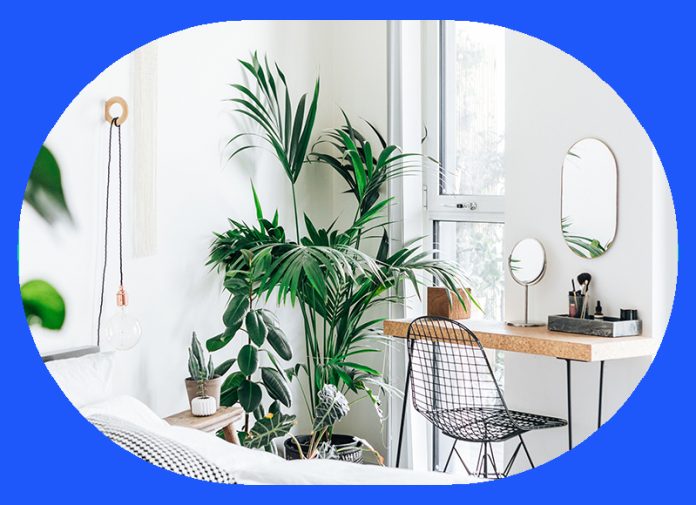Ah, sleep. Perhaps ever elusive, or maybe you just can’t get enough…rest can be tricky when the world is going a mile a minute. Bedrooms are meant to be a relaxing oasis that help you feel calm, relaxed, and well-rested, but with technology and stress battling for dominance, it can be hard to make your bedroom inviting.
Getty
One botanical way to solve your rest problems can be interior landscape design, otherwise known as ‘plant-scaping’. According to Lisa of Stylize, a home stager, ‘plants help to bring the outdoors in and replicate the natural environment’. This natural fragrance combined with the greenery plants can bring into our bedroom helps keep us calm and induce good, restful sleep, as well as making our bedrooms look more inviting.
Caring for indoor plants has also been shown to reduce blood pressure and help improve your mood.
The best house plants for your bedroom
James Folger, Founder at The Stem, a London-based plant shop, suggests selecting plants that go through photosynthesis at night. ‘During photosynthesis, (the process of plants using water, light, and carbon dioxide to create oxygen and energy), plants absorb carbon dioxide and emit oxygen.
The majority of plants carry out their photosynthesis process during the daytime…However, about 5-10% of plants follow a different photosynthesis process called Crassulacean Acid Metabolism (CAM). CAM tends to occur in plants native to arid desert regions such as cacti and succulents, or orchids.’
 Getty
Getty
Folger suggests that these types of plants make the best bedroom plants for sleep as they are pumping out oxygen and assisting with air purification too. Examples of these include aloe vera, snake plants and peace lilies, which are often small and compact to fit nicely on your bedroom table.
READ MORE: THE BEST ARTIFICIAL FLOWERS
Snake Plants are amongst the bestselling house plants in the UK, and for a good reason – they’re hardy and great at absorbing harsh air toxins and helping with allergies.

Houseplant care gurus Fiddle and Thorn also add the Chinese money plants (below) to the list of what will look great next to your bed, but if you notice any crispy spots make sure it’s not getting too much heat.
‘You want to choose plants that don’t completely take over the space but instead add a little bit of calmness into your bedroom’ they suggest.
 Getty
Getty
If insomnia is a problem, Plant Doctor Richard Cheshire suggests a Valerian Plant which will ‘look beautiful in your bedroom thanks to its small pink and white flowers’. This plant has been used for centuries to help with sleep problems such as insomnia due to its sweet scent.
Jasmine and Lavender plants are another great plant to combat stress and lack of sleep, with studies showing that these plants can be used to reduce anxiety levels, both in its plant form and by essential oil.
 Getty
Getty
Finally, Boston Ferns are recommended by Dan Bruce, co-founder of Leafy, an indoor plant shop. The Boston Fern, he says, stands out as it restores natural moisture to the air, which also helps moisturize the skin and combat irritable noses or throats.
How to care for houseplants in your bedroom
So, you’ve got a list of plants to add to your basket, but how should you care for them? Bruce suggests to focus on these key three areas:
Light
The winter months in the UK mean that we have fewer hours of daylight. Plants, just like humans, are dramatically affected by this change. For humans, it can bring on a downward turn in mood and health, and for plants it’s pretty much the same.
Understanding what type of plant you have, and in turn its needs, are vital to keeping it healthy during the wintertime. Most plants can’t survive without light, even when advertised as low light variations, as photosynthesis and those sweet Vitamin D rays are the lifeblood of any good indoor jungle.
 Getty
Getty
You’ll find that most plants in the UK require bright, indirect sunlight, which pretty much means a well-lit room. This doesn’t mean that they need to be out sunbathing 24/7, but you should note where the sun rises in your home and set your plants up there for the winter.
Water
Overwatering houseplants is by far the most common way to kill them, and this usually happens during winter. The lack of heat and light means that the water rests in the soil for longer.
So, when do you water them? The finger test is the best way for new plant parents to work out if their house plants need watering. Just feel the soil, and if it’s dry then pour on some water, if not let it rest some more. It’s that easy. The winter months for plants are like a hibernation system for animals—let them rest.
 Getty
Getty
Heat
For people in the UK, indoor heating is vital for keeping our bodies warm while it’s absolutely freezing outside, but for plants in the house, it can be a death sentence, at least when they are placed directly in front of a radiator. Having plants in a room with heating will be fine but try not to put them in the same vicinity as a radiator that’s on full blast, as it’ll dry out the plant in no time.

